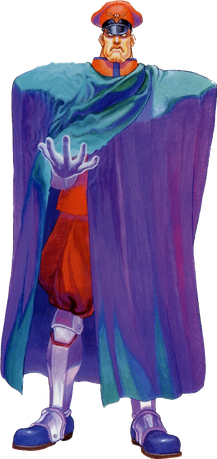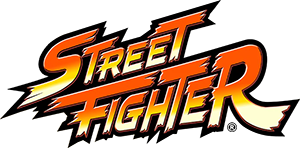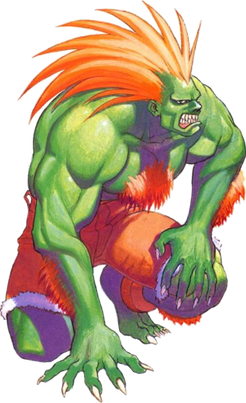
Ryu is a fictional character and the protagonist of Capcom's Street Fighter series. Having premiered in the first Street Fighter in 1987, Ryu appears as the game's lead character alongside his best friend and friendly rival Ken Masters. Other games in the series show Ryu to be highly focused on his training, aiming to become the strongest he can. Unable to control his dark nature, Ryu developed two alter egos: Evil Ryu, and Kage-naru mono or simply Kage.
Chun-Li is a fictional character in Capcom's Street Fighter video game series. She first appeared in Street Fighter II: The World Warrior in 1991 and is the first female playable character to appear in a fighting game to gain mainstream recognition. She is an expert martial artist and Interpol officer who restlessly seeks revenge for the death of her father at the hands of the evil M. Bison, leader of the Shadaloo crime syndicate.
Major Guile is a fictional character from Capcom's Street Fighter series of fighting games. He debuted as one of the original eight World Warriors in 1991's Street Fighter II and appeared in the game's subsequent updates. In the games he is portrayed as a major in the United States Air Force who is seeking to avenge the death of his Air Force buddy Charlie at the hands of the villainous dictator M. Bison.

Dhalsim is a fictional character in Capcom's Street Fighter series. He made his first appearance in Street Fighter II: The World Warrior in 1991. He sometimes goes by the alias "long-arm" and his fighting ability includes stretching his limbs. In the series, he is a mystical yogi who is loved by his villagers and family alike. He is also a pacifist who goes against his beliefs by entering the World Warrior tournament to raise money for his poor village. Throughout the series, Dhalsim is a character centered on morality and he has been noted for his other unique qualities.

M. Bison, also known as Vega, is a fictional character created by Capcom. First introduced in Street Fighter II: The World Warrior as the final boss of the game, he is a recurring character in the Street Fighter series of fighting games, acting as one of the series' main antagonists.

Cammy, also known by the codename Killer Bee, is a fictional character in the Street Fighter fighting game series created by Capcom. She debuted in 1993 as one of the four new characters in Super Street Fighter II: The New Challengers. She has also been featured in the Street Fighter Alpha games, first as a secret character and then as a playable character. The games explore her backstory as one of the evil M. Bison's deadliest assassins or "dolls" turned an amnesiac operative for MI6.
The main titles of the Street Fighter fighting game series have introduced a varied cast of 87 characters from the main series, and 34 from several spin-offs, for a total of 121 playable characters who originate from 24 different countries around the world, each with his or her unique fighting style. This is a list of playable characters and non-playable opponents from the whole franchise. They are categorized based on the game in which they first became playable, including the original Street Fighter game, the Street Fighter II series, the Street Fighter Alpha series, the Street Fighter III series, the Street Fighter IV series, Street Fighter V, Street Fighter 6 and other related games.

Edmond Honda, more commonly known as E. Honda, is a fictional character created by Capcom for the Street Fighter series of fighting games. Introduced in Street Fighter II as part of the starting lineup, he has appeared in Street Fighter Alpha 3, Street Fighter IV and the Capcom vs. SNK series, as well as several cameos. Honda is a professional sumo wrestler and sentō proprietor. He is one of the original eight playable characters in Street Fighter II, representing Japan alongside Ryu.

Street Fighter is a 1994 action film written and directed by Steven E. de Souza, based on the video game series of the same name produced by Capcom. It was one of two films released in 1994 specifically adapting Street Fighter II, following Street Fighter II: The Animated Movie. Distributed by Universal Pictures in the United States and Columbia TriStar Film Distributors International internationally, the film stars Jean-Claude Van Damme and Raul Julia along with supporting performances by Byron Mann, Damian Chapa, Kylie Minogue, Ming-Na Wen and Wes Studi. The adaptation focuses on the efforts by Colonel Guile to bring down General M. Bison (Julia), the military dictator and drug kingpin of Shadaloo City who aspires to conquer the world with an army of genetic supersoldiers, while enlisting the aid of street fighters Ryu (Mann) and Ken (Chapa) to infiltrate Bison's empire and help destroy it from within.

Street Fighter II: The Animated Movie, known as Street Fighter II Movie in Japan and Australia, is a 1994 anime film adaptation of the Street Fighter II fighting game written by Kenichi Imai, directed by Gisaburō Sugii and animated by Group TAC. The film, originally released in Japan on August 6, 1994, was released theatrically in the United Kingdom, France, and Spain, and was adapted into English in dubbed and subtitled format by Animaze for Manga Entertainment. It was distributed by Toei Company in Japan, while 20th Century Fox also distributed in other countries.

Street Fighter II V is an anime series produced by Group TAC, loosely based on the 1994 fighting game Super Street Fighter II Turbo. The series is directed by Gisaburo Sugii, who also directed Street Fighter II: The Animated Movie, and aired in Japan from 10 April to 27 November 1995 on YTV.

Street Fighter is an animated television series based on the Street Fighter video game franchise by Capcom. The series aired as part of the USA Network's Cartoon Express and Action Extreme Team lineups. It aired 26 episodes across two 13-episode seasons, which aired from 1995 to 1997.

Street Fighter II: Ryu, simply titled Street Fighter II in its English editions, is a manga series written and drawn by Masaomi Kanzaki that was serialized in the monthly Family Computer Magazine in 1993 and 1994. It is based on the fighting game of the same name and its subsequent iterations. The manga was produced prior to the release of Super Street Fighter II and only features the original twelve "World Warriors".

UDON's Street Fighter comic book series are based on the Street Fighter video game franchise published under license from Capcom. This series draws not only on the established Street Fighter canon, but also occasionally addresses various continuity retcons, and even draws from fanon and non-official sources as well. UDON's Street Fighter comics are stated to share the same continuity with other Capcom franchises like Darkstalkers, Rival Schools and Final Fight.

Street Fighter: The Legend of Chun-Li is a 2009 American action film released as a non-canonical spin-off and theatrical tie-in to Street Fighter IV. Produced by Capcom and Hyde Park Entertainment, the story follows the quest of Street Fighter character Chun-Li, who is portrayed by Kristin Kreuk. Its story is before the events of the original Street Fighter as it follows Chun-Li's personal history and her journey for justice. The film co-stars Neal McDonough as M. Bison, Chris Klein as Charlie, Michael Clarke Duncan as Balrog, and Black Eyed Peas member Taboo as Vega. The Legend of Chun-Li was released on February 27, 2009 by 20th Century Fox, and became a critical and commercial failure. A new Street Fighter film is in the works at Legendary Entertainment.

Street Fighter is a Japanese media franchise centered on a series of fighting games developed and published by Capcom. The first game in the series was released in 1987, followed by six other main series games, various spin-offs and crossovers, and numerous appearances in other media. Its best-selling 1991 release Street Fighter II established many of the conventions of the one-on-one fighting genre.

Street Fighter: The Movie is a 1995 fighting game released as an arcade game. The game is based on the 1994 live-action Street Fighter film, itself based on the Street Fighter series of fighting games, and uses digitized images of the film's cast. The game was developed by Chicago-based Incredible Technologies and distributed to the arcades by Capcom.
Street Fighter is a comic series based on the game series of the same name that ran for three issues from August to November 1993, published by Malibu Comics. Set after the events of the original Street Fighter game, the series focused on M. Bison's attempts at taking over the world and eliminate those Street Fighters that he sees as a threat to his plans.

Zangief, based on Russian Зангиев, often called the Red Cyclone, is a fictional character in Capcom's Street Fighter series. Considered to be the first controllable fighting game character whose moveset is centered on grappling, he made his first appearance in Street Fighter II: The World Warrior in 1991. In the series, he is a professional wrestler that fights to prove Russia's superiority over other nations' fighters. He was the canon grand champion of Street Fighter IV, being the only character to defeat Seth.

Blanka also known by his birth name Jimmy is a fictional character in Capcom's Street Fighter fighting game series. He first appeared in the 1991 video game Street Fighter II as one of eight playable characters, and was subsequently featured in sequel and spin-off games. Blanka is also present in a number of Capcom's crossover games, including the SNK vs. Capcom series. The character has appeared in other media adaptations of the franchise, including an animated film, a live-action movie, an animated television series, a comic book and manga series.














